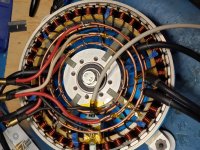mxlemming
100 kW
- Joined
- Jul 17, 2020
- Messages
- 1,122
kubark42 said:mxlemming said:I spent ages looking at your pics. Far longer than I should have.
I am really sorry for that, but I wanted to say a sincere thanks for encouraging me to try the modification. I think I'd still be trying to wrap my head around it if it hadn't been for your help.
VESC has matured a lot, and we're doing what we can to move it even further along. There's an exciting future for VESC, I think it has cracked the code for a viable open-source high-power ESC.
I wouldn't have tried to help if it wasn't interesting to me. Please post all the results/video when you get it running with 2 VESCs.
I have a love hate relationship with VESC. Love the interfaces, the logging etc, hate the random screaming of motors, propensity for self destruction... I've burnt more hours trying to get VESC to work on a board I made than I spent coding my entire FOC. But it does work better than mine, when it works...
Keep up the good work. I've got 5x 12fet IMS boards in the post relying on the VESC code to run.


